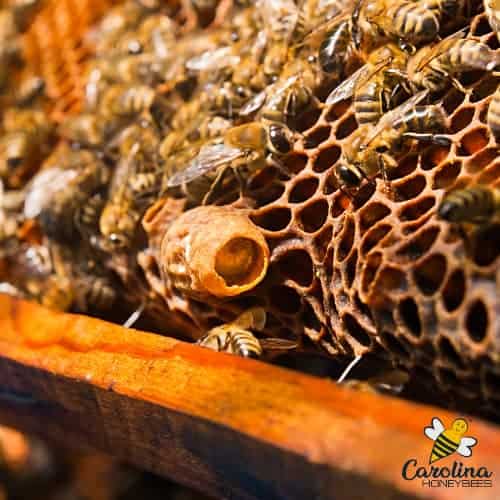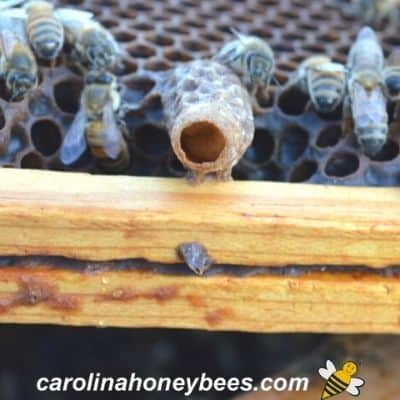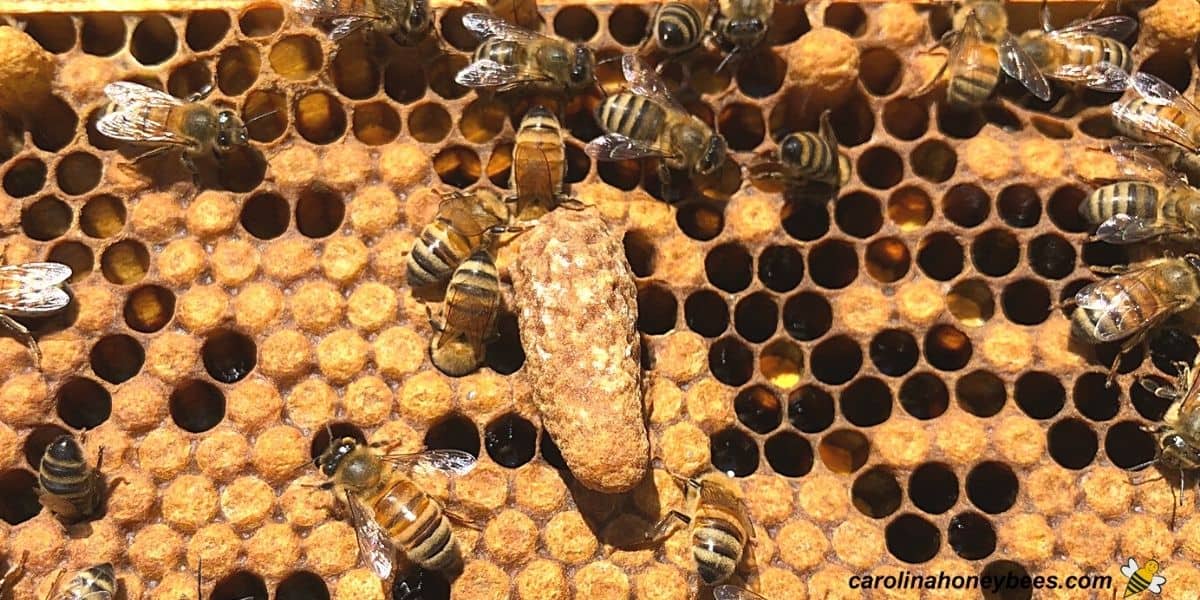Queen Cells
The appearance of queen cells in a honey bee colony can be considered a blessing or a curse to a beekeeper. We understand that the colony is preparing to make a new queen. But why? Is there a problem? Does the beekeeper need to do something? Let’s investigate some queen cell basics and attempt to learn more about why you may find them in your hive.

One of the most remarkable things about a honey bee colony is their ability to endure. A queen bee is the most essential colony member. It’s a good thing the bees have a plan.
What are Queen Cells?
New beekeepers often say that a queen cell looks like a big peanut laying on the comb. Because the queen bee is larger in size (longer) than workers, she can not develop in a normal, small cell.
Queen cells may be located anywhere on the comb. Along the bottom of the frames, on the surface or even hidden away in the sides. There may be 1 cell, several or many.
Should the beekeeper do something or leave the bees to their own devices? The answer depends on the condition of the colony and the goals of the beekeeper.
3 Types of Queen Cells in a Hive
The process of building and maturing queen cells takes time. This is not a decision that the colony makes overnight. It is the job of the beekeeper to try to decide what the presence of these cells means.
We generally name these cells according to the reason we believe the bees are making them. Yet, at the end of the day – they are all just queen cells.
Honey bees build 3 types of queen cells:
- Swarm
- Supersedure
- Emergency
How does the beekeeper know which kind of cell is present? We make educated guesses in most cases but there are some clues to consider.
Swarm Cells
Honey bee swarming is a natural occurrence for bees. When a colony swarms, a queen (usually the old one) and about half the population of bees leave.
A strong honey bee colony is likely to produce swarm cells in the Spring. But, it can happen at any time during the warm months.
Before the swarm leaves, numerous queen cells are constructed. These are called swarm cells because their construction is part of swarm preparations. Once the developing queen larva are capped and ready to emerge, the swarm leaves.
Swarm cells are most commonly seen along the bottom of frames. A colony can swarm with only a few (or one) but it is normal to see many.
Supersedure Cells
Several supersedure queen cells are produced when the colony needs to replace their current queen.
As the queen bee ages, she shows a decline in egg laying or reduced queen pheromones. When this happens, the bees will usually kill the queen and make plans to replace her.

Supersedure cells can be anywhere in the brood nest area. But, you will most often find them on the face of the comb – not near the bottom of a frame.
And, there will be fewer supersedure cells – maybe 3 or 4 instead of 6 or more than is common for swarming.
Emergency Cells
With supersedure and swarm cells the colony had time to plan. This gives the colony time to select the best young larva for producing a new queen.
Emergency queen cells however are different. They are exactly that – an emergency. Sometimes, a queen is lost suddenly. Perhaps, she dies from disease or is killed by robber bees. Or, maybe a beekeeper accidentally squeezes her between frames.
If the queen bee dies, the colony knows it is in a difficult situation- emergency cells are constructed anywhere young larva are available. You many see only one or two.
This can indicate a lack of suitable age female bee larva. There is always a danger that less desirable larva may not produce the best queen.

Stages of Development
- cup – egg
- open cells -larval development
- capped cell – pupa
- emerging queen – adult
Queen Cups
The beekeeper may notice small acorns shaped structures on the surface of the comb. These are called queen cups.
Queen cups may become the very first or pre-stage of a true queen cell. But, seeing these is no cause for alarm. It does not mean the colony is preparing a queen – at least not yet.
In practice, we don’t designate a cup as a true cell until it contains an egg or larva. Why? Because some colonies keep several queen cups on hand all year.
It appears to be a genetic tendency (connected to the type of honey bee) because not every colony does this. Perhaps, it is some type of inherited survival tactic to have some cups in place, just in case they are needed.
Some colonies may keep 10 or more of them in place on the comb- year round. Yet, the sight of them often frightens beginning beekeepers.
Open Queen Cells
A queen cup may never progress to a true cell – sometimes they are torn down or sit unused for years. But, once you see an egg or bee larva in there – it is game on!
In this larval stage, the young queen floats on a bed of milky food. We used to believe that a queen larva was only fed royal jelly but researchers seem to have disproven that idea.
It is the quality and quantity of food in this cell that is responsible for the quality of the developing queen. Worker bees are busily increasing the size of the cell as the queen larva develops.

Beekeeping Terminology
When multiple cells are being constructed along the bottom of the frames, they are often signs of imminent swarming (but not always).
Notice the difference in this beekeeping terminology and understand that some beekeepers use different terms. In general, “open” means an uncapped cell with a queen larva. It does not refer to a cell that has “opened” and the new queen emerged.

Capped Cells
Sometimes, queen cells at the capped stage are easy to spot in most cases. But, they can be rather small. It almost seems as though the bees are trying to hide them.
Once the cell is capped, no more feeding is taking place. But, the queen larvae can still consume some of the food insider her cell.
Then, the larva enters the pupal stage, she spins a cocoon and completes the transformation into an adult bee.

Emerged Queens
Around day 16, a fully formed adult virgin queen will emerge from her cell. Just prior to emergence it is not unusual for some of the workers to use their teeth or mandibles to chew off some of the end tip to aid in her release.
An open cell that has a “trap door” at the bottom means the new queen is released. Finding a queen cell, or several, that are torn open on the side is an indication that the colony has reared a new queen and she has killed her rivals.
When a new virgin emerges from her cell, the queen will emit piping sounds called – tooting. Often, virgins still inside their queen cells will perform quacking signals in return. The new virgin will seek them out.
After destroying her rivals, she will mature for a few days, fly to a drone congregation area to mate and then return to begin her life’s work – laying eggs.

Why Bees Build Queen Cells
There are primarily 3 reasons a colony may begin building queen cells.
- current queen is dead
- current queen is failing
- they are preparing to swarm
A honey bee colony has a miraculous capacity to produce a new queen when one is needed. But, there is one requirement – they must have the materials needed.
Worker in the hive choose very young female larvae ideally no more the 2 days old. This is the beginning of the life cycle of the queen honey bee. In about 16 days on average, a new queen will emerge.
Should You Remove Queen Cells?
Upon finding queen cells in your hive, the temptation is to quickly cut them out. Don’t do it. Your first task is to try to decide why the colony is raising a new queen before removing any anything.
Cutting out swarm cells will not stop a colony from swarming. First of all, it is darn hard to locate each one in a crowded colony. Also, the colony will simply build more.
Complete your hive inspection and try to understand the why/ Then, you must decide what to do with any queen cells in the hive.

FAQs
True queen cells look similar to large peanuts in the shell that hang down the face of the comb. They are long with a mottled wax surface.
The number of the queen cells present and their location tell the story of the hive’s status. They can be present anywhere in the brood nest area.
Sometimes they are found on the bottom of frames and others will be scattered on the face of the comb.
These small acorn-sized structures are the first stage of the queen cell timeline. They are prepared in advance of actual queen rearing.
Their presence is no reason for beekeeper concern until an egg or larva is present inside. Once you see larva in the cup, worker bees are serious about producing a queen.
The term “charged” is also sometimes used for a cell that has a developing queen inside – the same as the term “open”.
Final Thoughts
Learn how to identify a queen cell and understand what the bees are telling you. You many need to interfere or leave the bees to their own plans. But, look before you leap and don’t be too quick to cut them out. Honey bee reproduction is fascinating at the individual and colony level. It takes time to learn how to read the bees and have a good “guess” at what they are doing.

